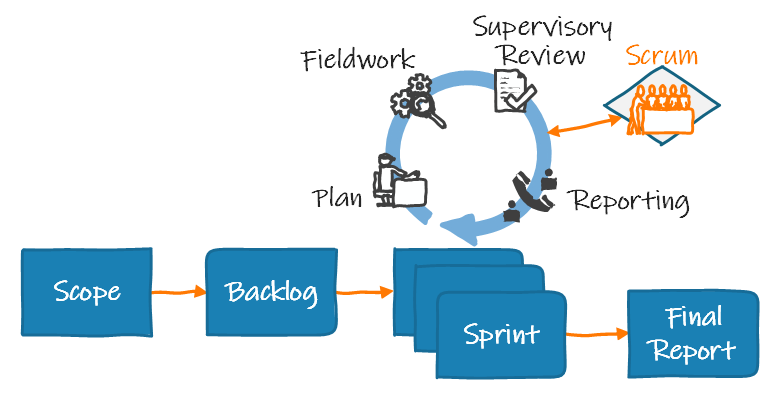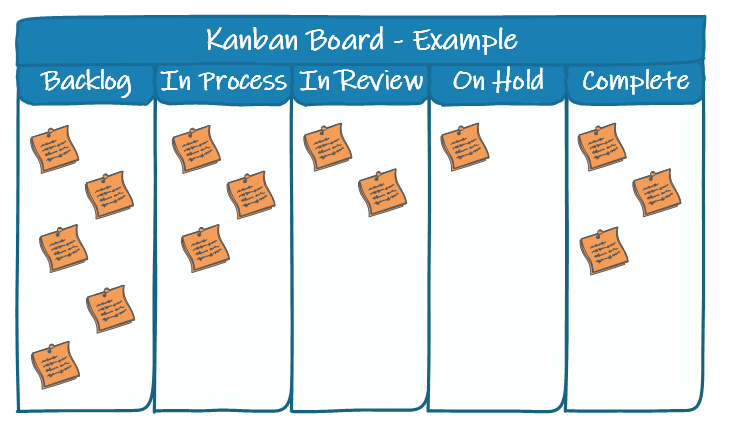Achieving or optimizing flexibility and efficiency while delivering timely, quality work is a familiar aspiration that has never been more crucial than in our current environment. The words “Agile” and “Lean” sound like qualities of elite athletes, and when applied to an internal audit function, they will enrich audit team performance by:
- Improving collaboration leading to better engagement.
- Increasing efficiency through higher-quality outputs and clearer outcomes.
- Enhancing value through risk-specific insights.
- Accelerating response times to changing risks or business needs.
- Empowering audit roles through a flexible audit approach.
Agile Methodology
Agile began as a software development methodology for delivering tested software in short iterations, and involving internal customers to refine the scope and requirements which resulted in increased customer satisfaction due to higher quality outputs. While the traditional audit approach follows a linear and sequential start to end process, the Agile approach groups open audit tasks from a backlog into predefined timeframes called sprints, and incorporates iterative feedback on scope and fieldwork results during team stand-up or scrum meetings. The reporting segment is a check-in with the auditees to communicate status and vet potential findings with the intent of facilitating the production and communication of the final report.

The Agile methodology relies heavily on frequent and instant communication. This helps build trust, improves problem solving, helps teams make decisions faster and adapt to fast-changing priorities, all of which translates well into the improved efficiencies sought after in the world of Internal Audit.
Lean Philosophy
Lean is a philosophy originating from the manufacturing industry for delivering value as defined through the eyes of the customer while eliminating waste and continually seeking to improve products and processes. When adapted to Internal Audit, Lean techniques involve analysis and brainstorming to redesign approaches, and deliver content and stakeholder communication. For some audit teams, this is an opportunity to accelerate innovation by harnessing automation to achieve lean techniques such as:
- Robotic process automation (RPA) to speed up repetitive manual testing or allow for continuous monitoring, which provides greater audit coverage with less resources.
- Data analytics to focus in on key risks, cover 100 percent of a population in less time than sampling, and aid auditors in presenting meaningful insights through graphs and charts to customers.
- Governance, Risk, and Compliance (GRC) solutions to streamline the audit process and synchronize decentralized teams and compliance activity across an enterprise.
Adopting Agile and Lean
Adoption is not a one-size-fits-all approach, making it important for organizations to tailor Agile and Lean techniques and tools to meet their needs and objectives, and to determine the best fit for the audit department, the industry, and stakeholders. So that value-add benefits have clear outcomes derived from adopting the Agile approach, management should consider the need for change management, and review the level of effort required to train and support teams in order to ensure a successful transition and adoption of the appropriate tools and techniques.
Some audit departments may hesitate to adopt Agile and Lean techniques due to capacity constraint concerns. To counter this, teams who have adopted these methods have selected and scaled different facets of the audit process to manage level of effort in the following ways:
- By Audit Type: Adopt Agile and Lean for audits that have a less certain scope, such as audits of new processes or systems, as well as unregulated processes, as audits of areas with a known scope (i.e., reoccurring audits such as regulatory audits) may not benefit as much from the iterative processes that continuously refine scope, procedures, and outputs.
- Scrum Calibration: Calibrate the cadence of the scrum meetings based on audit needs in order to achieve optimal value of the audit (e.g., daily versus once a week). Well-timed scrum meetings with the audit team will ensure that the team is adjusting its scope and focus based on the risk data it is reviewing.
- Report Meeting Calibration: Calibrate the cadence of meetings with the auditees to discuss potential findings and general audit status, including any obstacles to engagement progress. These meetings will help to ensure analysis of results are accurate, minimize “surprises” at the end, and enable efficient audit reporting. Moreover, these meetings will help drive auditee accountability for delivering audit requests in a timely manner.
- Process Management Visualization: Consider using visualization tools such as the Kanban method to visually show the movement from backlog into sprints through review and completion. It is a helpful tool to facilitate transparency and communication that can be leveraged during the scrum and the report meetings throughout an Internal Audit engagement.

Next Steps
Key questions teams should answer when kicking off Agile and Lean audit activities include:
- What level of support exists from my sponsors and stakeholders?
- Will a business case help garner additional support needed?
- What Agile concepts, tools, and techniques should be applied?
- Do we have the level of resources (skills and technology) needed within the audit department for a successful implementation?
- What audit department needs and objectives will Agile and Lean serve to fulfill?